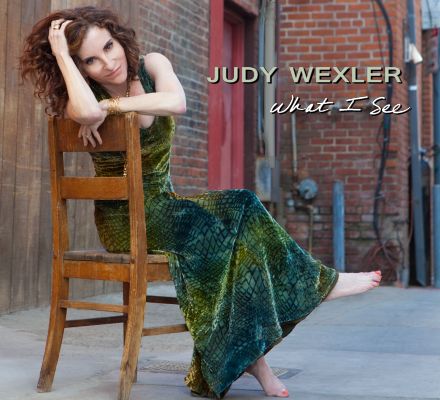
Liner Notes by Andrew Gilbert
Perusing Judy Wexler’s brief but bountiful discography, it quickly becomes apparent that the Los Angeles jazz vocalist has assiduously assembled a singularly rich treasure trove of overlooked songs. Where far too many jazz singers round up the usual American Songbook suspects, Wexler displays an unerring ear for underexposed gems. But a closer listen reveals that Wexler is far more than a savvy song sleuth.
Arranged by Jeff Colella
featuring
Judy Wexler, vocals
Jeff Colella, piano
Larry Koonse, guitar & ukulele
Ron Stout, trumpet & flugelhorn
Bob Sheppard, alto flute & bass clarinet
Scott Whitfield, trombone
Chris Colangelo, bass
Steve Hass, drums
Billy Hulting, percussion
“Though Judy Wexler’s reputation as one of the West Coast’s most compelling vocalists was cemented some time ago, What I See, her fourth release, suggests a heightened maturity, an even greater sense of assured imagination. Much like Abbey Lincoln—and at this point in Wexler’s musical progress, the comparison is quite valid—her skills as an actress are skillfully exercised, adding vivid shadings to her interpretations.”
– Christopher Loudon, JazzTimes
“Judy Wexler is more than a mere singer of songs. She’s an actress, mood painter, song archaeologist, and vocalist par excellence. What I See is a marvel of sincerity and beauty.”
– Dan Bilawsky, All About Jazz
“A hard-driving kind of seduction… Wexler can’t help become a hipster darling with this outing.”
– Chris Spector, Midwest Record
“One of the best jazz albums of the year!”
– Robert Nicosia, Music Man Blog
“Surely the ocean and the light and the lifestyle somehow combine to suffuse West Coast jazz with a very particular magic. What I See is a superb example of the continuing legacy of this brand of jazz, a tradition started by pioneers such as Christy and Rugolo and carried on by Wexler, Colella, and this fine gathering of musicians.
– Florence Wetzel, All About Jazz
“What I See is one of the finer examples of what connecting to a song is all about… awesome!”
– Brent Black, Critical Jazz
“If you’re up for an adventurous program exploring what may be new territory, this is an album you are going to want to hear.”
– Jack Goodstein, Seattle Post-Intelligencer
“What I See from Judy Wexler yields surprisingly terrific finds, primarily from material that has been available but overlooked. A very fine vocal talent also surfaces. With a plethora of female vocalists umbilically tied to the Songbook and the Ipanema Beach’s sandy sounds, Wexler – by way of taking a road less traveled – delivers a refreshing, satisfying musical excavation.”
– Nick Mondello, All About Jazz
“What I See continues and elevates Wexler’s reputation as a most effective interpreter of the stories and lyrics of a wide range of songwriters, culling mostly less familiar material from diverse sources, and turning each tune into a new jazz standard.”
– Andrea Canter, Jazz Police
“Fresh and delicious!”
– Peter LaBarbara, The Jazz Zine
“In terms of originality via interpretation, this singer is a deconstructionist who tears down the elements to find what others have missed, then puts it all together again, but always with a bright positive spin even when wistful. There’s always an element of dream here. The blissful equanimity with which Wexler addresses the philosophy and music is exquisite, so much so that there’s nothing to add or subtract.”
– Mark S. Tucker, F.A.M.E. (Folk & Acoustic Music Exchange)
